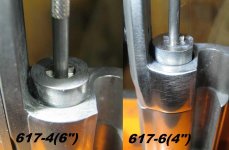On any forcing cone, too small is worse than too big. Too small shaves off parts of the bullet as it comes out of the cylinder, deforming the bullet and causing leading with lead bullets, or shaving off the copper on jacketed bullets. If the chamber is not closely aligned to the barrel bore, the problem is worse. Too small and/or poor alignment will mean leading, damaged bullets and large groups. A barrel constriction just ahead of the f/c will do the same. Some guns have all these problems together.
A larger forcing cone eliminates these problems if it's done correctly. The f/c needs to be cut concentric to the bore, and have a reasonably smooth finish.
A too large mouth isn't a problem, in and of itself, but it can mean that the f/c is too long, possibly allowing the bullet to become unstable if the ends are unsupported going from cylinder throat to rifling.
Ideally, you want the forcing cone as short as possible, while still having a large enough opening that the bullet never touches an edge of the hole. Like most things in life, there is a compromise between largeness of hole and shortness of taper. The gage helps you find a happy middle ground. I tend to lean toward the upper end of the gage.
All calibers work the same in this regard.

